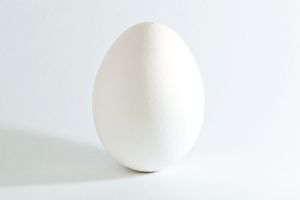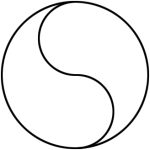 We know the eternal riddle as “which came first – the chicken or the egg?” But when you’re giving a lesson to horse and rider, there’s a question that’s more important, which is “who comes first – the horse or the rider?”
We know the eternal riddle as “which came first – the chicken or the egg?” But when you’re giving a lesson to horse and rider, there’s a question that’s more important, which is “who comes first – the horse or the rider?”
Most instructors address themselves exclusively to the rider, every lesson. Some tell their riders to make the horse do something, but don’t explain how. Some make improvements in the rider’s position that in turn improve the horse’s way of going. Some focus on exercises or gymnastics, as part of a set program of instruction.
Rare is the instructor who focuses attention on the horse first, not simply as an athlete but also as an individual. I’m sure you’ve heard instructors say, “the horse comes first,” but the phrase usually refers to the horse’s welfare (and it’s too often said but not meant, just like those electoral promises). I agree that the horse’s welfare should come first, but I also think that focusing attention on the horse first, as an individual, can improve the horse’s performance.
After all, what is the essence of a great performance under saddle? It’s the partnership between horse and rider. And a great partnership isn’t based on selfishness. It’s not based on using; it’s based on giving. I’ll admit, it’s hard to give the horse something that he or she rarely gets, which is to come first. But the payoff can be huge.
At the beginning of a lesson, I like to check in with my student and I like to check in with the horse. You’ll often hear me say “Hi” to both. I like to get a feel for how horse and rider are doing, how their week was, what time they spent working together, what problems, if any, arose, and what successes they had together. I encourage a warmup on a loose rein, so that chatting time, while the horse is warming up, allows me to help formulate a plan for the lesson that day.
It also allows me to observe. I get to see how both horse and rider are doing physically. And, just as importantly, I get to see how they’re doing mentally and emotionally. Riders show you, even if they don’t tell you. And horses let you know if they know you care.
If that sounds crazy to you, you have blinkers on, or your instructors do. If you’re a student, try watching a lesson and see if you can tell how the horse and rider are doing that day. If you’re an instructor, put the goals on the shelf when you walk into the ring, and decide who needs more help that day, the rider or the horse. If a horse is stiff or distracted or irritable, it’s the instructor’s job not only to observe it and find out why, but to fix it. That’s when I put the horse first. The lesson will be structured around the horse, with exercises chosen to address the horse’s issue. If the rider wants to work on leg yielding but the horse is counter bending in the corners, we’ll fix the counter bending even if we don’t work on leg yielding that day. If the horse loves to jump and hasn’t had the opportunity for a week for some reason, we’ll jump even if the rider would rather work on canter transitions. Because at that point, making the horse happy in his work will benefit the partnership more than improving transitions.
Similarly, if a rider is struggling with developing a good feel of the horse’s mouth, we may work at the walk for the whole lesson, even if it does nothing to improve the horse’s gaits. If a rider needs to regain confidence, maybe we’ll need to canter, or lower the fences, or get out of the ring. And it will be all about helping the rider feel good, and have virtually nothing to do with schooling the horse.
You might think that all my students are frustrated and all their horses are spoiled, but you would be mistaken. Most of my students are amazed at how problems they’ve struggled with for years, suddenly get solved. Part of my secret is listening to the horse, and being willing to put the horse ahead of the rider when the horse needs help more than the rider does.
 When you help the horse, you help the rider, and when you help the rider, you help the horse.
When you help the horse, you help the rider, and when you help the rider, you help the horse.
It’s yin-yang. So next time you change direction inside a circle, remember that the geometry you’re riding with your horse is also something to remember in your training.
And remember to give.
Happy spring.

Katie, thanks for penning this excellent article. I have been fortunate in that my past and current dressage instructors have been sensitive to the needs of my horses as well as my needs. If my little black mare starts out tense, exercises are selected that give her confidence and let her relax before proceeding to something else. If the young gelding feels sluggish in the arena, we go work in the field for the first 20 minutes of the lesson and then return to the arena. If I’ve had some tense days at the office and really can’t face doing 15m circles, low jumps or trail riding gets me back in the zone. Everyone should want a willing and attentive dance partner and that sometimes requires, as you say, putting preconceived lesson goals on the shelf!
LikeLike
Lovely to read you again, Katie! Great post – we’ve missed your advice. Having seen KarenRO’s other comment too on decreasing speed, I looked back on that post and was glad to see that we have incorporated a lot of your advice into schooling and (except on exciting hacks) pulling and rushing is now largely a thing of the past – so much so that I also looked back to the post on increasing speed without nagging! So… just a long distance student’s vote of thanks for your excellent instruction – please keep it coming! And as to the post above, I try hard to tailor the sessions to Señor’s mood and, when I can, lug my tape player down to the arena, with appropriate music 🙂
LikeLike
Oh, I’m so happy to hear your news, and I thank you so much for posting it. I’ve been so busy of late, so new posts are few and far between, but I’m so happy to see that people are still discovering the blog, and that you’ve come back to it. It’s gratifying for me to hear that some of my advice has helped and that pulling and rushing is now largely a thing of the past for you. So often, it becomes a habit, like bickering in a bad marriage. Congratulations and I hope it just gets better and better.
LikeLike
I often find that the horse’s and the human’s needs are contrary and therefore I have trouble to get the two aligned. But the solution might be just to focus on one and make one more important (at this moment in time) than the other. Thanks for that hint. I taught an absolute beginner lately and the horse was more nervous than he usually is. So I focussed on him, trying to reassure him to keep the novice rider safe. I was a bit sorry that I couldn’t do more for her, but as it turned out it wasn’t that bad as without me commenting everything she did she had time to just sit and get used to the movements.
LikeLike
Hello Nadja and thank you so much for contributing your experience here. It is interesting how by helping the horse, you helped your novice rider. I think that sometimes, with nervous animals (human and equine), simply having a different focus can create relaxation, and sometimes that alone goes a long way to solving problems.
LikeLike
What an appropriate blog to read after our lesson with you tonight 🙂 As you helped me correct my seat and position, G rebalanced, and so in turn by helping the rider you helped the horse. I don’t mind working at the walk at all, as I’m still learning the feel of when G is balanced and not, when the shoulder pops out or not 🙂 So many small nuances that a rider can overlook without the proper guidance and openness to feel for it. It was wonderful working with you again and look forward to our next lesson.
LikeLike
Hi Kate — How nice to hear from you on the blog today! I was so pleased with the progress that you and G made over the winter, and although you had to wait a bit to get in the groove this year, everything you’ve been working on is paying off. You have a horse that is listening and responsive and more balanced each time I see you. Congratulations. It was wonderful to work with you both again for me as well, and I, too, look forward to your next lesson.
LikeLike